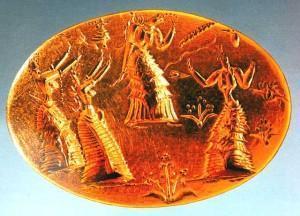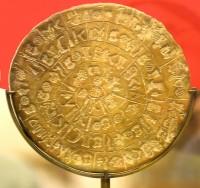Heraklion Archaeological Museum

Gold signet ring found in a tomb at Isopata, in the vicinity of Knossos. On the bezel is a representation of women in ecstatic ritual dance, in a meadow with lilies. The smaller figure is considered to be a goddess descending from the sky. On the ground, the signs of an eye and snakes can also be seen. It is a true masterpiece of Minoan goldwork, dated to the LM II period (15th century B.C.)
-.- -.- -.- -.- -.- -.- -.- -.- -.- -.- -.- -.- -.- -.-
The Heraklion Archaelogical Museum was built between 1937 and 1940, designed by P Karantinos. The site had been occupied during the Venetian Period by an imposing Catholic monastery of St. Francis, which was destroyed by the earthquake of 1856. The Museum houses archaeological finds from all over Crete. Its most important exhibits are the treasures of the earliest European civilization, the Minoan, which can be admired here in all of its historical continuity.
The present display was organized between 1951 and 1964 by N. Platon and St. Alexiou, both Ephors of Antiquities. The order in which the exhibits are presented is based on the chronological development of the Minoan civilization, and reflects both the history of the excavations and the major discoveries made on Crete at the beginning of the century (Palaces at Knossos, Phaistos, Malia, etc.). The exhibition contains objects mainly from central and east Crete, covering 5500 years of Cretan History.
ROOM I
Neolithic period (5000-2600 BC): Pottery, figurines, and tools from Neolithic sites in central and east Crete. Pre-palatial period (2600-1900 BC): Pottery of various styles, stone vases, seals, figurines, and jewelry from Pre-palatial settlements and tombs.
ROOM II
Old Palace period (1900-1700 BC): Finds from the Palaces at Knossos and Malia, and votive and cult objects from peak sanctuaries.
 ROOM III Old Palace period (1900-1700 BC): Finds from the Palace at Phaistos, Kamares-ware vases, clay sealings, the must-see Phaistos disk, cult objects.
ROOM IV
New Palace period (1700-1450 BC): Finds from the Palaces at Knossos, Phaistos, and Malia.
ROOM V
Late Palace period (1450-1400 BC): Finds from the region of Knossos, clay Linear A and B tablets, 'palace' style and 'floral' style pottery.
ROOM VI
Finds from the New Palace and Post-palace cemeteries at Knossos and Phaistos (1450-1300 BC).
ROOM VII  New Palace period (1700-1450 BC): Finds from megara, villas, and caves in central Crete.
ROOM VIII
Finds from the Palace at Zakros (1700-1450 BC).
ROOM IX
Finds from New Palace settlements in east Crete (1700-1450 BC) (Palaeokastro, Gournia, Pseira, etc).
ROOM X
Post-Palace period (1400-1150 BC): Finds from Knossos, Phaistos, Gortys, Seteia, etc.
ROOM XI
Sub-Minoan and early Geometric periods (1150-800 BC): Finds from various sites in Crete and the cemeteries at Prinias, the tombs at Fortetsa - Knossos, the Cave of the goddess Eileithyia at Inatos, etc.
ROOM XII
Geometric and Oriental periods (800-650 BC): Finds from the sanctuary at Symi Viannou and from tombs at Knossos, Arkades, Fortetsa, etc.
ROOM XIII (VESTIBULE)
Collection of painted clay sarcophagi belonging to Post-Palace times (1400-1150 BC).
ROOM XIV-XVI
Display of Minoan wall paintings (1600-1400 BC) from the Palace at Knossos, the villas at Agia Triada, Amnissos, etc.
ROOM XVII
Exhibits from the Yamalakis Collection dating from the Neolithic to the Venetian period.
ROOM XVIII
Greek and Roman sculpture, pottery, and miniature art (7th c. BC-4th c.AD) from Gortys, Praisos, etc.
ROOM XIX
Collection of sculpture of the archaic period (7th-6th c. BC). Works of early 'Daedalic' sculpture and Archaic metalwork.
ROOM XX
Classical, Hellenistic, and Roman sculpture from Gortys, Knossos, Chersonissos, etc. (5th c. BC-4th C. AD).

|



